Tag: nature
At the rim
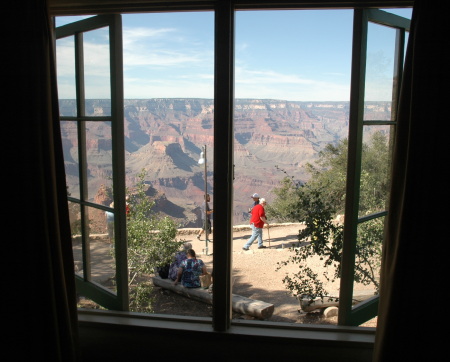
On a lark, last week I called Xanterra, the vendor that runs the hotels on the south rim of the Grand Canyon, to see if they had any rooms available anytime during the summer. Diane and I wanted to do a day hike down the Hermit Trail, and to do it we needed to stay at a hotel the night before and the night after.
To my surprise, they had a rim view room available in Bright Angel Lodge, for tonight and tomorrow. The picture on the right is taken from our room, right after we arrived earlier today. I am right now sitting at that window, watching the sun set on the canyon buttes even as I type. Yowza!
I will post more tonight, and some tomorrow night as well. I will also do my podcast with John Batchelor tomorrow, live, from this room. Most cool, I must say.

On a lark, last week I called Xanterra, the vendor that runs the hotels on the south rim of the Grand Canyon, to see if they had any rooms available anytime during the summer. Diane and I wanted to do a day hike down the Hermit Trail, and to do it we needed to stay at a hotel the night before and the night after.
To my surprise, they had a rim view room available in Bright Angel Lodge, for tonight and tomorrow. The picture on the right is taken from our room, right after we arrived earlier today. I am right now sitting at that window, watching the sun set on the canyon buttes even as I type. Yowza!
I will post more tonight, and some tomorrow night as well. I will also do my podcast with John Batchelor tomorrow, live, from this room. Most cool, I must say.
Off to Israel + new op-ed!
My April travels continue. It has been too long since I traveled to Israel to visit family, so today I am heading out for the long flight, arriving tomorrow afternoon. I will be there until April 20. I expect I will be able to post, as I have in the past, though my commentary will likely be reduced somewhat.
Note that I will have a new op-ed published sometime this week at The Federalist entitled “What Trump’s space policy should really do.” I am positive that my conclusions will not be what most people expect. The op-ed was inspired by this comment by Edward Thelen, part of comments in connection with this Zimmerman/Batchelor podcast, where I talked about space exploration in the context of the American settlement of the west.
The comparison with the American west is appropriate. There have been other expansions throughout the world, too. In the 19th century, the US was not the only country that had a frontier. We have several examples of expansion from which to learn, but the frontiers in the Americas were clearly the largest, complete with immigration from the Old World straight to the frontier.
An example of a lesson — beyond Robert’s example of the Homesteading Act — is the need for better communication between the US east coast and California. Messages and people needed to move across the continent in far less time and in a safer manner than those that were available in 1860, so government funded a transcontinental railroad, a line longer than had ever been built or operated before. Earthbound or space-born governments may also have needs for similar large projects. Although the needs of We the People has been shown to be best met through private-ownership of free-market capitalist commerce, there will be times when government should also fund projects that solve its needs.
Edward was suggesting that the focus of the federal government — and Trump’s space policy — should be building an infrastructure that will make it easier for private companies and individuals to work in space. My initial response had agreed with him:
What NASA should do is build the kind of infrastructure that private enterprise needs to explore the Moon, the asteroids, and Mars. Build a communications network. Put communications satellites behind the Moon. Set up radiation monitors that private tourists trips will need to monitor solar and cosmic radiation. And even here, the model should be that used in the west with the transcontinental railroad, where the government hired private companies to do the work for it.
I need to think about this more. This needs to be written up properly.
In thinking about it, however, I completely rejected my initial response, and Edward’s suggestion. The infrastructure that the federal government needs to build in space has nothing to do with physical objects. This is the mistake everyone has been making for decades. In my op-ed I argue for something else entirely, and I hope the Trump administration is listening.
Stay tuned. When the Federalist op-ed gets posted I will post the url here immediately.
My April travels continue. It has been too long since I traveled to Israel to visit family, so today I am heading out for the long flight, arriving tomorrow afternoon. I will be there until April 20. I expect I will be able to post, as I have in the past, though my commentary will likely be reduced somewhat.
Note that I will have a new op-ed published sometime this week at The Federalist entitled “What Trump’s space policy should really do.” I am positive that my conclusions will not be what most people expect. The op-ed was inspired by this comment by Edward Thelen, part of comments in connection with this Zimmerman/Batchelor podcast, where I talked about space exploration in the context of the American settlement of the west.
The comparison with the American west is appropriate. There have been other expansions throughout the world, too. In the 19th century, the US was not the only country that had a frontier. We have several examples of expansion from which to learn, but the frontiers in the Americas were clearly the largest, complete with immigration from the Old World straight to the frontier.
An example of a lesson — beyond Robert’s example of the Homesteading Act — is the need for better communication between the US east coast and California. Messages and people needed to move across the continent in far less time and in a safer manner than those that were available in 1860, so government funded a transcontinental railroad, a line longer than had ever been built or operated before. Earthbound or space-born governments may also have needs for similar large projects. Although the needs of We the People has been shown to be best met through private-ownership of free-market capitalist commerce, there will be times when government should also fund projects that solve its needs.
Edward was suggesting that the focus of the federal government — and Trump’s space policy — should be building an infrastructure that will make it easier for private companies and individuals to work in space. My initial response had agreed with him:
What NASA should do is build the kind of infrastructure that private enterprise needs to explore the Moon, the asteroids, and Mars. Build a communications network. Put communications satellites behind the Moon. Set up radiation monitors that private tourists trips will need to monitor solar and cosmic radiation. And even here, the model should be that used in the west with the transcontinental railroad, where the government hired private companies to do the work for it.
I need to think about this more. This needs to be written up properly.
In thinking about it, however, I completely rejected my initial response, and Edward’s suggestion. The infrastructure that the federal government needs to build in space has nothing to do with physical objects. This is the mistake everyone has been making for decades. In my op-ed I argue for something else entirely, and I hope the Trump administration is listening.
Stay tuned. When the Federalist op-ed gets posted I will post the url here immediately.
Another Grand Canyon tour

Because I live in southern Arizona, I take advantage of this location to make an annual trip to the Grand Canyon. On my previous trips I’ve talked about the right way to hike the canyon (slowly!) and then provided some suggestions for proper preparation.
This time I am simply going to suggest two hikes. One is very easy and should be done by every visitor to the south rim. The other hike is for those who go to the bottom, and reserve themselves one day there for a day hike.
» Read more
Returning to the Grand Canyon
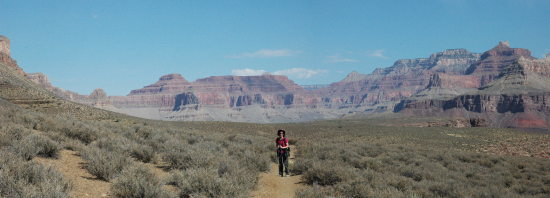
I am off for my annual hike to the bottom of the Grand Canyon. While I might be able to post this coming weekend, once we head down on Monday morning I will be out of touch through Wednesday.

I am off for my annual hike to the bottom of the Grand Canyon. While I might be able to post this coming weekend, once we head down on Monday morning I will be out of touch through Wednesday.
Off to Belize
Today, Wednesday, I head to the airport to return to the western regions of Belize for a week of cave exploration and mapping. Last time I was there in May we began a cave survey. I am now the cartographer for this project, and this time I hope we can finish it.
I intend to post while in Belize, though it will likely have to wait until each evening when we get back from the caves. I also intend to do my Batchelor appearances, but this time live from Mayan Mountain Lodge in San Ignacio, where we will be staying. The lodge was gracious enough in May to let me use their office and phone, and I expect they will be agreeable again this time.
Anyway, off for more adventure. The world is much too fascinating a place to see it just from my desk by way of the internet. You have to get out and see it for real whenever you can!
Today, Wednesday, I head to the airport to return to the western regions of Belize for a week of cave exploration and mapping. Last time I was there in May we began a cave survey. I am now the cartographer for this project, and this time I hope we can finish it.
I intend to post while in Belize, though it will likely have to wait until each evening when we get back from the caves. I also intend to do my Batchelor appearances, but this time live from Mayan Mountain Lodge in San Ignacio, where we will be staying. The lodge was gracious enough in May to let me use their office and phone, and I expect they will be agreeable again this time.
Anyway, off for more adventure. The world is much too fascinating a place to see it just from my desk by way of the internet. You have to get out and see it for real whenever you can!
Hunting Javelinas
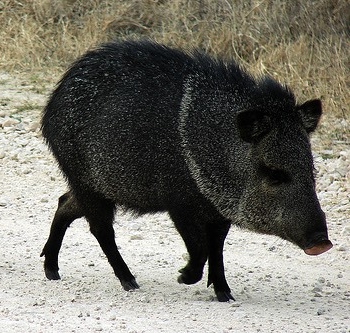
This past weekend I participated on my third hunt, the second in which I was carrying my own weapon with the possibility of making my own kill. (For my first hunting experience I only came along as an observer.) The goal was to find and shoot a javelina, a boarlike wild animal whose range covers the southwestern United States down into Central America.
The hunt itself was what Arizona Game and Fish calls a HAM hunt, specifically limited to the use of handguns, archery, or muzzleloaders. This means that the only long gun you can use must be loaded through the muzzle one shot at a time, use black powder, and function somewhat like an old-fashioned musket. My weapon of choice was the 1911 pistol I use for bullseye competition, with a red dot scope, a customized left-handed grip, a carefully adjusted trigger, and in general carefully adjusted to be as accurate as possible. With this gun, shooting 45 caliber ammo, I can hit the black bullseye 50 yards away shooting one-armed about 70% of the time. At shorter distances, using two hands, I can easily group my shots in a space less than a few inches across. (Such accuracy on my part is actually not very impressive. Among bullseye shooters I am about average. The public’s general belief that pistols are not accurate beyond 20 feet is simply wrong. Practice, make sure your gun functions as it should, and you will reliably be able to hit your target at 50 yards.)
Since I really have no knowledge about hunting, I wouldn’t have dreamed of doing this without some help. My mentor this weekend was a local friend, Gary Kessinger, who has been hunting for decades, has a number of record kills, and routinely comes home successfully from his hunts. When I mentioned to Gary my desire to learn more about hunting and see how it is done, he gladly offered to guide me through the process. He hadn’t hunted javelinas much in the past few years, but decided to get his own license or tag so that he could shoot one himself.
As I told Gary on Saturday morning, I am essentially a babe in the woods, and would do whatever he suggested. My attitude was that I was the equivalent of a 10-year-old on his first hunt. Anything I accomplished well would be a success, even if it was merely learning how to spot javelinas on a distant hillside using binoculars.
» Read more
Famous sequoia tree falls
The Pioneer Cabin Tree, the California sequoia that had had a tunnel carved in it in the 1880s so that people, and for a time cars, could travel through, has fallen.
Jim Allday of Arnold is a volunteer at the park who was working there Sunday. He said the tree went down about 2 p.m. and “shattered” on impact. He said people had been walking through the tree as recently as Sunday morning.
It’s not clear why the tree fell, but probably had to do with the giant sequoia’s shallow root system — the roots only go about two or four feet deep — and the fact that the trail around the tree was flooded due to rain. “When I went out there (Sunday afternoon), the trail was literally a river, the trail is washed out,” Allday said. “I could see the tree on the ground, it looked like it was laying in a pond or lake with a river running through it.”
The Pioneer Cabin Tree, the California sequoia that had had a tunnel carved in it in the 1880s so that people, and for a time cars, could travel through, has fallen.
Jim Allday of Arnold is a volunteer at the park who was working there Sunday. He said the tree went down about 2 p.m. and “shattered” on impact. He said people had been walking through the tree as recently as Sunday morning.
It’s not clear why the tree fell, but probably had to do with the giant sequoia’s shallow root system — the roots only go about two or four feet deep — and the fact that the trail around the tree was flooded due to rain. “When I went out there (Sunday afternoon), the trail was literally a river, the trail is washed out,” Allday said. “I could see the tree on the ground, it looked like it was laying in a pond or lake with a river running through it.”
Canyoneering in Death Valley
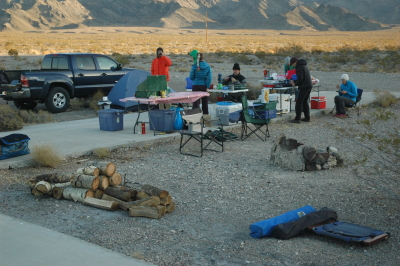
This past Thanksgiving weekend I joined some caving and canyoneering friends in Death Valley to celebrate the holiday in the great outdoors as well as explore some of the park’s more inaccessible canyons. We did not camp in the park, since campfires are not allowed and the park has a size limit for groups. Instead, we camped on BLM land just outside the park, in what appeared to be an abandoned RV trailer park that canyoneerers call Slabby Acres.
First a primer. Regular readers will know that I have been doing cave exploration and mapping now for about thirty years. This recreational activity not only involves knowing how to use survey instruments in a cave, you need also to be trained in the vertical rope techniques required to reach some remote places underground, sometimes dropping multiple pits on the way in and climbing those same domes on the way out.
Canyoneering is somewhat similar to caving. Just like caving you need to know how to travel over boulders and rough terrain and also know how to rappel and climb ropes. Unlike caving the canyons are open to the sky, and you rarely climb the ropes to travel up the canyon. In canyoneering the goal is to find the head of the canyon and travel down its many drops to come out at the bottom safely, all the while getting to see some wild, majestic, and rarely seen places. In addition, modern canyoneering rarely involves virgin exploration. Most canyoneerers visit already explored canyons whose details are well documented so that they know what ropes to bring as well as how to find the canyons.
This was our goal this past weekend. Some of the western cavers who have joined my survey projects and learned how to cave survey are also active canyoneerers. While none of us had ever visited the canyons on our trip list, several were very experienced with finding and traversing places they had never been before. My plan was to follow them and enjoy the experience. Below are my pictures during one of this weekend’s canyoneering trips. The canyon is Scorpion Canyon. It was the first we visited and was relatively easy to do, only 4.6 miles long with only six rappels and only an 1,800 foot elevation drop. It would take us over one of the mountain ranges that form the eastern wall of Death Valley. In fact, this was how I was going to enter Death Valley for the first time. Rather than drive in, like most tourists, I would rappel in.
» Read more
Back from Death Valley
I have returned from Death Valley after a wonderful five days exploring four different canyons in this quite amazing place. I will do some catch up posting tonight and tomorrow, as well as post a description, with some pictures, of my experience rappelling down some of the rarely visited canyons of the park.
I have returned from Death Valley after a wonderful five days exploring four different canyons in this quite amazing place. I will do some catch up posting tonight and tomorrow, as well as post a description, with some pictures, of my experience rappelling down some of the rarely visited canyons of the park.
The world’s longest and highest glass-bottomed bridge
Link here. Lots of great pictures of this new pedestrian bridge in China, including one of a reporter trying (and failing) to use a sledge hammer to break the glass.
China’s economy might have a lot of holes and might face collapse, as many experts have been telling me for years, but at the same time they seem to be successfully harnessing the success they’ve had in the past few decades to get very creative. That creativity suggests to me the collapse is not guaranteed, and will not be as severe as predicted.
Link here. Lots of great pictures of this new pedestrian bridge in China, including one of a reporter trying (and failing) to use a sledge hammer to break the glass.
China’s economy might have a lot of holes and might face collapse, as many experts have been telling me for years, but at the same time they seem to be successfully harnessing the success they’ve had in the past few decades to get very creative. That creativity suggests to me the collapse is not guaranteed, and will not be as severe as predicted.
The Grand Canyon
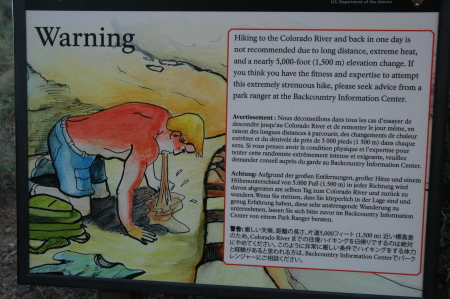
When I posted here on Behind the Black that Diane and I were on our way to the Grand Canyon for our annual hike to the bottom, one of my readers, Keith Douglas, commented that he and his family would be there about the same time. In trying unsuccessfully to meet up, at one point Keith mentioned that his two kids, aged 24 and 23, were proposing they hike into the canyon. Keith emailed me to ask, “From what I read, hiking into the canyon and out is not recommended for a one day activity. What about halfway and back up? Can that be done in an afternoon? It seems pretty hot.” I responded,
Though one can hike down and up in one day, this is not recommended for most. Usually you need to be in very good condition and young. It also helps if you are a long distance runner. Hiking down to Indian Gardens [about two thirds of the way down] can be done as a day trip, but if you don’t hike a lot it will be an intense and long experience. Also, having the right pack and gear is essential! People who go carrying a one liter bottle of water and no hat are guaranteed to suffer.
I didn’t tell them they couldn’t do it, or that they shouldn’t, or that it wasn’t possible. I simply outlined some of the basics for doing it, and let them decide what to do.
Keith answered, with humor, “Thanks for helping me talk my kids out of a hike down.” He later added, “I read a hiking guide on the nps website. It seems to be designed to discourage canyon hiking rather than prepare novice hikers.”
In one sentence Keith encapsulated the problem with almost all of the advice the Park Service gives about the Grand Canyon.
» Read more
Three stops on Iceland’s golden circle
An evening pause: From the youtube webpage: “The three main stops on the Golden Circle route in Iceland: 1. The magnificent Gullfoss waterfall; 2. Haukadalur geothermal area (widely known as Geysir) – famous for its geysers and termal pools (Strokkur being the most active); 3. Thingvellir National Park, where the Icelandic Parliament was established in 930, and where the continental drift between Europe and North America can be easily noticed.”
The music is “The Most Beautiful Things” by Michael Murphy.
Hat tip Danae, who added “Just chillin’ with sights for a hot summer day.”
Lower Waterholes Canyon, Arizona
An evening pause: Waterholes Canyon is a side canyon leading down into the Colorado River, north of the Grand Canyon. The people canyoneering here are caving friends of mine. The video was created by Kimberly Franke, whom you pretty much only see in the opening still shot, since she was wearing the camera most of the time. Her husband Kevin Franke is also a fellow caver who is the person with the white helmet and thick whitish beard. The woman in the red helmet doing the very long drop near the end is Belinda Norby, also a fellow caver. The music is “Point of No Return” by Roger Subirana Mata.
The world is filled with amazing things to see. This video does a nice job of highlighting just one of them.
Belize and Guatemala
During my caving trip to Belize last week, we reserved one day off to do some sightseeing. The goal that day was to visit the Mayan ruins of Tikal, across the border in Guatemala about three hours from our resort in Belize.
Arranging this trip was not straightforward. We couldn’t simply get in our rental car and drive off. Locals have found it a bad idea to drive Belizean vehicles in Guatemala, as they are more likely to be attacked. So, the resort arranged for a Belizean driver to take us to the border, where it also arranged for us to be met by a Guatemalan tour guide with her own car.
On the way, we drove through several small towns of both Guatemala and Belize, as shown by the two photos below, with Santa Elena, Belize on top.
» Read more
In the wild
An evening pause: A beautiful nature video from National Geographic. Though it contains lots of cute animals, it also shows them in the wild, as they really are, hunting and being hunted. I am thus reminded of Tennyson’s description of nature, “red in tooth and claw,” from his poem In Memoriam, written at the death of a close friend.
… A monster then, a dream,
A discord. Dragons of the prime,
That tare each other in their slime,
Were mellow music match’d with him.
O life as futile, then, as frail!
O for thy voice to sooth and bless!
What hope of answer, or redress?
Behind the veil, behind the veil.
Hat tip George Petricko.
Building a log cabin, alone
An evening pause: This is the first part of a longer work. To quote the youtube webpage,
“Alone in the Wilderness” is the story of Dick Proenneke living in the Alaska wilderness. Dick filmed his adventures so he could show his relatives in the lower 48 states what life was like in Alaska, building his cabin, hunting for food and exploring the area. Bob Swerer has taken the best footage from Dick’s films and he has created 3 videos about Dick, “Alone in the Wilderness”, “Alaska, Silence and Solitude” and “The Frozen North”
I like this because it gives a good hint at what life was really like for the original mountain men who first explored the American west. They were resourceful, clever, strong-willed, and technologically very sophisticated. Dick Proenneke shows us how to do it again.
Hat tip Rocco.
An evening pause: This is the first part of a longer work. To quote the youtube webpage,
“Alone in the Wilderness” is the story of Dick Proenneke living in the Alaska wilderness. Dick filmed his adventures so he could show his relatives in the lower 48 states what life was like in Alaska, building his cabin, hunting for food and exploring the area. Bob Swerer has taken the best footage from Dick’s films and he has created 3 videos about Dick, “Alone in the Wilderness”, “Alaska, Silence and Solitude” and “The Frozen North”
I like this because it gives a good hint at what life was really like for the original mountain men who first explored the American west. They were resourceful, clever, strong-willed, and technologically very sophisticated. Dick Proenneke shows us how to do it again.
Hat tip Rocco.
El Camino del Rey
An evening pause: I posted this video of El Camino del Rey (The King’s Road) back in 2010, but when Willi Kusche suggested it I thought, why not post it again? It shows a walk along the crumbling walkway high on the cliff walls of El Chorro canyon in Andalusia, Spain and is not for those with any fear of heights. Considering the craziness we are enduring with this year’s presidential election, I think this hike is relatively mild in comparison.
Balloon Flight over Cappadocia, Turkey
Oregon as seen by a modern drone
An evening pause: The music is by “Lost in You” by Lior. The video demonstrates the endless possibilities that drones will bring to us in future years.
Hat tip Danae.
The Pacific Crest Trail in Three Minutes
An evening pause: I prefer to do it a bit slower, but this will give the couch potatoes here a sense of why I and others like to go hiking.
Hat tip Danae.
MTNS – Lost track of time
An evening pause: The song, which is really nice, is really just background music to a beautiful video of what it is like to fly fish in Montana. As always, I want to note the sophistication of the human engineering and design that makes this activity possible. It is as beautiful as the countryside and the music.
Hat tip Rocco.
Real clam digging
An evening pause: Rocco had suggested this short video about the joys of going out and digging clams. I prefer the video below, of a real clam doing its own digging, because it shows us something we normally don’t see and that is really amazing. Who would have thought that a clam could bury itself so quickly, with a single digging foot?
Back from the Grand Canyon
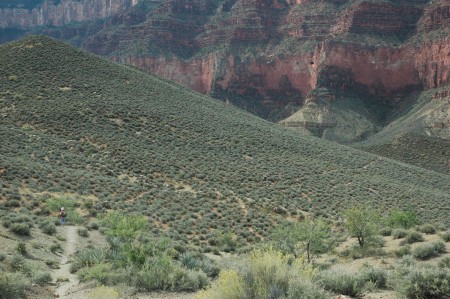
Diane and I just got home and are in the process of catching up. Posting shall resume this weekend, maybe tonight! Meanwhile, I was pleasantly surprised that even with my absence, my thoughtful readers (even ones I sometimes disagree with) have been keeping things lively here with some intelligent debate. Kudos to you all!
And as always, the Canyon was what it always is, magnificent and awe-inspiring. The picture on the right shows us hiking on the Tonto Plateau, about 4000 feet down from the rim but above the Colorado River 1000 feet below. If you look real close you can see the tiny figures of Diane and others on the trail.

Diane and I just got home and are in the process of catching up. Posting shall resume this weekend, maybe tonight! Meanwhile, I was pleasantly surprised that even with my absence, my thoughtful readers (even ones I sometimes disagree with) have been keeping things lively here with some intelligent debate. Kudos to you all!
And as always, the Canyon was what it always is, magnificent and awe-inspiring. The picture on the right shows us hiking on the Tonto Plateau, about 4000 feet down from the rim but above the Colorado River 1000 feet below. If you look real close you can see the tiny figures of Diane and others on the trail.
Back to the Grand Canyon

Diane and I are about to leave for our annual hike to the bottom of the Grand Canyon. Though I might be able to post during the drive north today and from the hotel on the rim tonight, from Tuesday until Thursday I will be out of touch with the world of computers, a welcome break that I do need periodically.
Unlike previous trips, this time we are going with a bunch of friends. Last year I obtained a reservation for a 10-person cabin at Phantom Ranch in the Canyon so that we could all be together. Should be a lot of fun!

Diane and I are about to leave for our annual hike to the bottom of the Grand Canyon. Though I might be able to post during the drive north today and from the hotel on the rim tonight, from Tuesday until Thursday I will be out of touch with the world of computers, a welcome break that I do need periodically.
Unlike previous trips, this time we are going with a bunch of friends. Last year I obtained a reservation for a 10-person cabin at Phantom Ranch in the Canyon so that we could all be together. Should be a lot of fun!
The elephants of Bushcamp Company’s Mfuwe Lodge
An evening pause: As the youtube website explains, “This is perhaps the only hotel in the world where you may need to make way for passing elephants when checking in. During the month of November, a small herd of pachyderms nonchalantly tromps through reception on their way to a wild mango tree.”
Hat tip Danae.
Tooth of Time
An evening pause: Tonight we take a short aerial tour of a mountaintop that every Boy Scout who has backpacked at the Philmont Scout Ranch in New Mexico will immediately recognize.
Hat tip to Steve Golson, whose son is currently doing this very hike.
What cavers do for fun
An evening pause: Hat to Phill Oltmann, whose comment was, “Too tight for me!” Me too, though I definitely would be willing to try.
July 4th flash flood captured on video
An evening pause: Hat tip to caver Ray Keeler. As noted by Walt Willis, who had tipped Ray off and knows some of the people on this rafting trip,
They were rafting on the San Juan river and camped in a side canyon for the night. It started to rain so they all went under an overhang to stay dry (good decision). The person in blue (doing all the yelling) is my Cousin.
There are obvious lessons to be learned here. One never ever discounts “Luck”. They lost some of their gear but left with their lives. My Cousin was yelling at one of her friends not to go out and try and save anything.“ He thought better of the idea and stayed put. She proved that the sign above my desk is not always correct (“You Can’t Fix Stupid”).
Finger Rock Fire update
During the night the fire seemed to subside somewhat, and today it is raining. I can still see smoke, but no flames. However, the cloudy weather, plus morning is a poor time of day to observe details in the Santa Catalinas because of the angle of the sun, means that this is not a certain observation.
The Forest Service has sent crews up to check on the situation and will report an update later this morning. This news report says nothing about the fire spreading into Ventana Canyon, as it appeared to do to me last night. Hopefully I was wrong and the fire only appeared larger than it was.
During the night the fire seemed to subside somewhat, and today it is raining. I can still see smoke, but no flames. However, the cloudy weather, plus morning is a poor time of day to observe details in the Santa Catalinas because of the angle of the sun, means that this is not a certain observation.
The Forest Service has sent crews up to check on the situation and will report an update later this morning. This news report says nothing about the fire spreading into Ventana Canyon, as it appeared to do to me last night. Hopefully I was wrong and the fire only appeared larger than it was.
